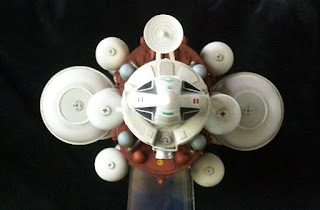September 13, 1999....
Nuclear Waste Disposal Area 2 is in imminent danger of a catastophic explosion. Due to the quick thinking of Commander John Koenig and tireless cargo Eagle crews, the large atomic pile of waste is disipated and the crisis averted. Unfortunately, there is now no where to safely store the radioactive waste without the possiblility of the same event happening again. So with the moon rotten with atomic garbage a new solution had to be found quickly. Two years later, the first of the "Buzzards" was launched, after being constructed at the space dock. The program was to ship all of the remaining waste and the continuous stream of new waste from Earth to the sun and dump it there. Now in 2019, there are 11 funtioning Buzzards shipping atomic waste to the biggest incinerator we have....
For the model, I used parts from three primary sources. A leftover MPC Eagle kit, a very old tanker trailer, and the 1/72 Revell Space Shuttle I rescued from a garage sale. Also included are handfulls of greebles sourced from many armour and aircraft kits, other sweet shapes from various sources, and the trademark Kinder Egg. This model includes the epic amount of no less than 24 eggs; 20 regular and 4 of the jumbos! My stock has been severly depleted...
I wanted to keep the model in the "Space: 1999" style, being influenced by other vehicles in the series, like the Meta Probe, the Ultra Probe and the Super Swift. Measuring in at 36" long, its practically studio scale. Since the Eagle model is 1/72, that makes it 216' long (66 metres).
Conventional construction and modelling techniques. The most time consuming of the build was selecting and placing the grebbles as not to look over-cluttered, as well as adding raised panels. Besides the "Space: 1999" influence, I was also dabbling with some subtle Chris Foss graphics, but nothing too extreme (that is for other projects...). For the "dirtying down" process, I used good old pastels to bring out the features.
The concept is that upon reaching the "safe zone" near the sun, the command module and drive unit detatch, and the payload is sent into the corona to be destroyed. The separate units then link up and the Buzzard returns home for the next load. (Sorry, I didn't build the model with separation capabilities; this one is for long shots...). I envisioned this as an interim payload, partially painted. But future loads will be totally red oxide to save money.
This view reminds me of the episode "The Guardian of Piri". To stay in the "zone" I watched most episodes of "Space: 1999" during the six months of construction (except for several episodes from Season 2; some of them I just can't handle...), as well as other series and films from Anderson, and most especially, only those with practical effects! No CGI!
So "Space: 2019" won't be as exciting as the original. Looks like we now have "Movin On: 1999"! I'm sure with 11 ships running about out there we can come up with a decent series. Actually there are many plots available, such as:
-The ship malfunctions and the crew cannot alter course or disengage from the payload, and is doomed to do a "sun dive", until the obligatory deus ex machina of course
-an alien derelict is discovered on Mercury
-a ship is hijacked and held for ransom, otherwise the ship and payload will be crashed into Earth...
But I'm a modeller, not a writer....
I realize 2019 is not that far away, but in keeping with the series parameters, I thought it fitting. Also, 2019 is quite significant for another reason, and I will ask you to ponder that reference while the Buzzard flies overhead....
A very satisfying project! Thanks to all those mentioned above for the inspiration and continued entertainment! Now if ITV is interested in another sci-fi show, let's do lunch....










Very cool Nigel! I like the finished project even though I got a sneak peek just before they were done. I'll try to restore your supply of supplies like the kinder eggs. I'll bring you a care package around Christmas.
ReplyDelete